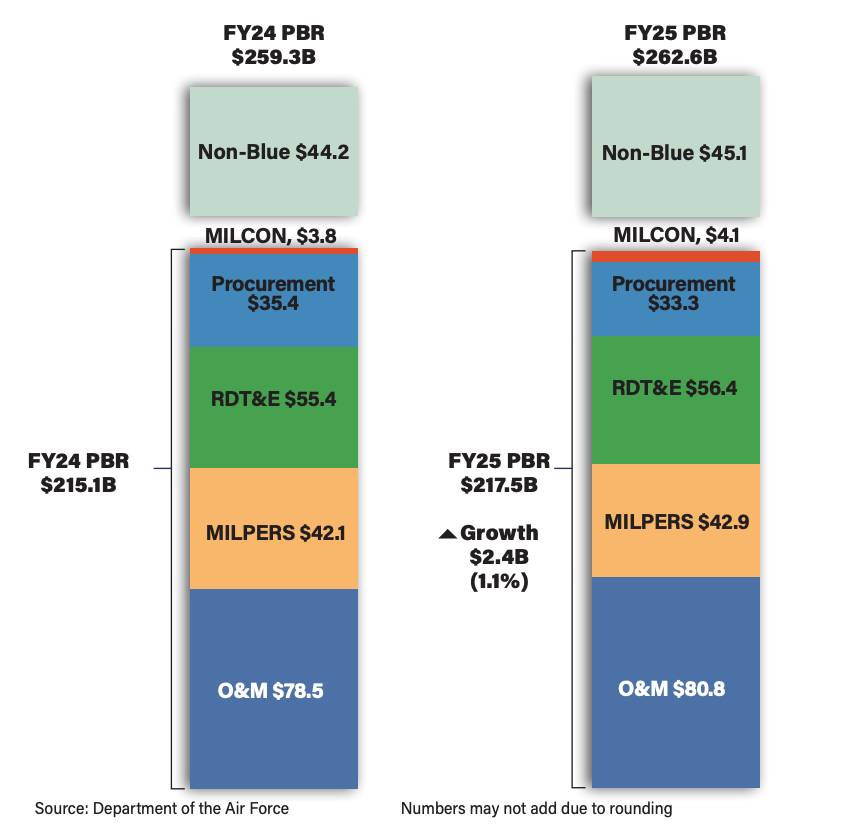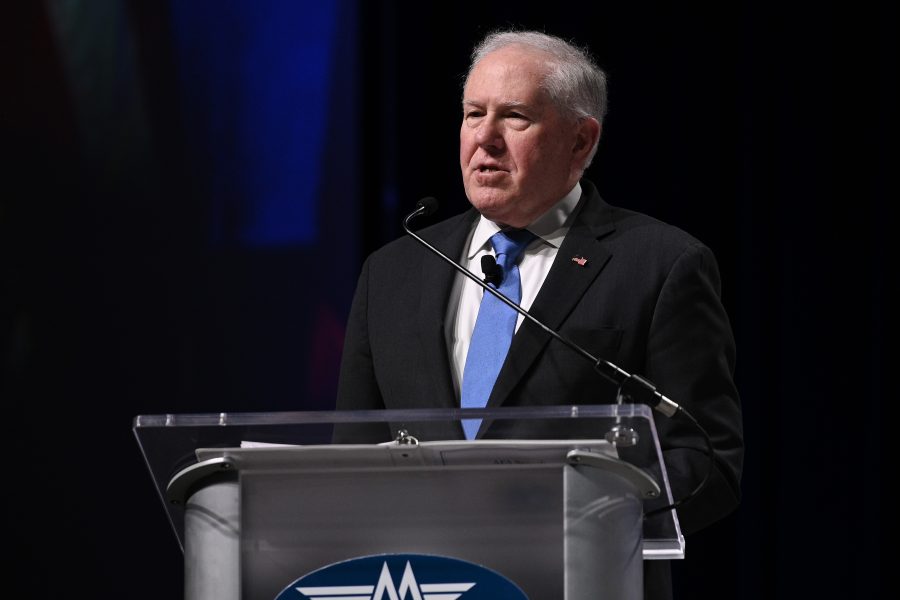The Air Force’s fiscal 2025 budget request is adequate and defensible but doesn’t provide the speed with which senior leaders would like to bring on new systems to compete with the likes of China, they said in rolling out the new spending plan.
All told, the Department of the Air Force is requesting a budget of $262.6 billion for 2025. That total includes $188.1 billion for the Air Force, $29.4 billion for the Space Force, and $45.1 billion in “pass through” funding that the Air Force does not control.
The Air Force request marks 1.6 percent growth, or $3 billion over the fiscal 2024 budget request, while the Space Force request marks a decline of $600 million, or 2 percent. All figures are in constant dollars, not adjusted for inflation, indicating both services would actually see a decline in buying power.
“We are not quite keeping up with inflation,” acting Air Force undersecretary Krysten Jones told reporters.
Air Force Secretary Frank Kendall hinted as much March 7 at the McAleese defense programs conference when he told attendees there was “no real growth” in the budget.

However, Kendall told reporters ahead of the budget rollout that “I consider this to be an acceptable budget. I can defend it.” The spending plan is “moving forward on the things that we prioritize. Again, I’d like to be able to move faster, but you know, we do have constraints.”
The Fiscal Responsibility Act, passed by Congress last summer—but after the Department of the Air Force had already largely built a budget—required DAF leaders to “make some hard choices to fit within those boundaries,” Kendall said.
Air Force acquisition executive Andrew Hunter told the McAleese defense conference on March 7 that the service had to cut around 2 percent from its budget topline due to the FRA. Though that percentage “sounds small,” Hunter said, the service could not touch personnel accounts, so the cuts fell disproportionately on modernization and readiness.
Air Force budget director Maj. Gen. Michael A. Greiner said the FRA reductions amounted to just over $2 billion.
However, those cuts will not have a dramatic effect on the Department of the Air Force’s recently-announced restructuring plans, Kendall said. Though new organizations will be created, “they’re going to be created out of pieces we already have,” he said, “so we’re not talking about big manpower increases, and we’re going to minimize, to the extent we can, the movement of people and the acquisition of real estate and so on.”
The “Re-Optimization for Great Power Competition” effort will not be “zero cost,” Kendall added, but he expected the chief expenses will come in the form of adding capabilities and resources to deployable wings. That cost won’t be known for a while as the service classifies wings and takes stock of what it needs.
In general, the Air Force’s budget outlook beyond 2025 appears challenging.
“We’ve got some tough choices … when we get to [FY] ’26, which we’re building now,” Kendall said. Among the challenges in that budget will be accommodating a nearly $40 billion overrun on the Sentinel intercontinental ballistic missile program, although the Air Force is looking for economies and that bill doesn’t have to be paid in a single year.
In making choices, Kendall said his priority “is to get to a next generation of capabilities” to offset China’s military advances. As a result, the budget seeks to “protect” Kendall’s seven Operational Imperatives—the key modernization investments he first outlined in 2022. Consequently, there was “a tradeoff” between what he called “the mid-term force”—things that are already developed and which the Air Force is buying—and research and development of “the longer-term force.”
“What we’re doing, essentially … is buying options for people to procure things in the future. So all that research and development essentially doesn’t give you anything immediately, it gives you an option to then exercise for production later,” he said.
As an example of leadership’s thinking, the budget reduces buying in-production F-35 and F-15EX fighters, but preserves previously-planned developmental funding for the Next-Generation Air Dominance (NGAD) fighter and the Collaborative Combat Aircraft program. The Air Force buy of F-35s drops from 48 in 2024 to 42 in 2025, and the buy of F-15EXs will drop from 24 to 18.
That will also reduce the program of record for the F-15EX from 104 to 98, with production ending in 2025, said Greiner. At one time, the Air Force expected to buy upwards of 180 F-15EXs.
Funding of NGAD and CCA development amounts to $3.3 billion in 2025, up $815 million and $165 million, respectively, from FY’24 requested levels. But for both programs, “life gets a lot harder after ’25,” Kendall said, without elaborating.
Jones said it will cost about $1 billion extra to achieve the same levels of readiness and flying hours in fiscal ’25 as it did in ’24. This drove “difficult decisions” in munitions, for example, where “we are buying, in some cases, slightly fewer munitions for the same price” as in fiscal 2024, she said.
Kendall said the Air Force is “trying to continue what we hope will be multiyear” contracts for the AIM-120 AMRAAM air-to-air missile, the AGM-158 JASSM-ER stealth ground-attack missile, and its variant, the LRASM anti-ship missile.
Absent congressional authority to do multiyear procurement—which allows buying in bigger lots and economic order quantities for materials—”the funding that we have laid in there [previously] will not be able to buy the items that we had planned for,” Greiner said.
“But either way, we have money in there, we’re going to continue to procure those munitions that we know are critical,” he said.
Strategic Funding
Developmental funding for the Sentinel ICBM stayed flat at $3.7 billion from fiscal 2024 to 2025. That’s in addition to $700 million in military construction costs.
Research, development, test, and evaluation funding for the B-21 bomber will decline from $3 billion to $2.7 billion. The budget also includes money for B-21 low-rate initial production procurement, but the number of aircraft and the amount of funding is classified.
B-52 engine, radar, and other upgrade development stays flat at $1 billion. The Long-Range Stand-Off missile (LRSO), the nuclear cruise missile that will equip the B-52 and later, the B-21, was funded at $623 million to continue design, development, and test.
Pilot Training
Asked about the ongoing pilot shortage, Kendall noted that flying hours tick up slightly in the ’25 budget, from 9 hours per month to 9.2 per pilot, for a total of 1.1 million flying hours, which officials hope will help retention and readiness. Kendall said he promised Air Force pilots that “we would not cut flying hours,” and former Chief of Staff—now Chairman of the Joint Chiefs—Gen. Charles Q. Brown Jr. told Kendall there would be increased risk if flying hours were reduced any further.
But Kendall also argued that the term “pilot shortage” is a misnomer. The Air Force can fill its cockpits, he said. Rather it has “a shortage of staff officers who were supposed to be pilots.”
There’s also no shortage of people who want to be pilots, Kendall added.
“The problem is the pipeline to produce,” he said, “And the biggest impediment in that is the T-38, and its reliability.” The T-38 is old, its engines are getting hard to repair, and the Air Force is “waiting for the T-7 to come online and replace it.”
The Air Force is in flight test with the T-7A, and the 2025 budget includes $233 million for seven airplanes. But the T-7 has been delayed and its initial operating capability, initially planned for this calendar year, will be deferred several years, forcing extended reliance on the T-38.
‘Right Direction’
Overall “we’re very, very fixated on being competitive with the pacing challenge” of China, Kendall said of the 2025 budget.
‘I think the budget that we’ve submitted moves us forward; not quite as fast as we would like to, but it moves us forward, in the right direction, while maintaining the current capabilities that are essential to the nation. So, I’m pretty comfortable with what we’re asking for, given the constraints that we have,” he said.
